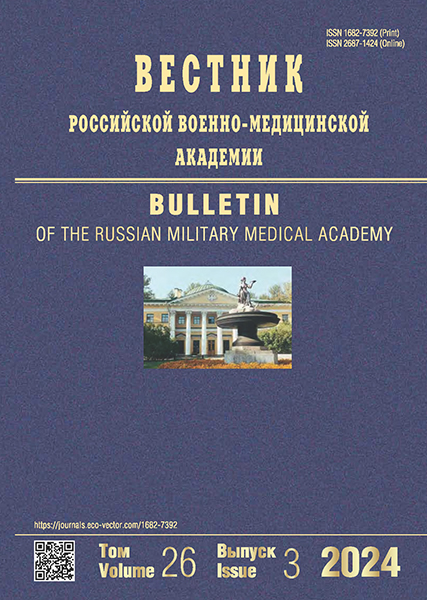个性化腰椎经椎弓根切除术的长期临床疗效和邻近近节段退行性疾病发病率分析
- 作者: Spiridonov A.V.1,2, Pestryakov Y.Y.1,2, Kalinin A.A.1,3, Byvaltsev V.A.1,3,4
-
隶属关系:
- Irkutsk State Medical University
- Regional Clinical Hospital of Krasnoyarsk
- Railway Clinical Hospital
- Irkutsk State Medical Academy of Postgraduate Education – branch of the Federal State Budgetary Educational Institution DPO RMANPO of the Ministry of Health of the Russian Federation
- 期: 卷 26, 编号 3 (2024)
- 页面: 399-410
- 栏目: Original Study Article
- ##submission.dateSubmitted##: 21.03.2024
- ##submission.dateAccepted##: 06.06.2024
- ##submission.datePublished##: 06.09.2024
- URL: https://journals.eco-vector.com/1682-7392/article/view/629309
- DOI: https://doi.org/10.17816/brmma629309
- ID: 629309
如何引用文章
详细
前瞻性评估个性化腰椎经椎间孔融合术的远期临床结果和邻近近节段退行性疾病的发生率。根据已建立的登记册,2015-2019年接受原发性开放式经椎间孔腰椎椎体切除术的209例患者被纳入观察性前瞻性多中心研究。手术按照公认的适应症在 LIV-SI 椎体运动节段水平进行。相邻椎体运动节段有不同程度的相邻节段原有退变。通过应用原始方法(俄罗斯联邦专利 2762496,2021 年 12 月 21 日,第 36 号公告)评估了近端椎体运动节段发生邻近节段退行性病变的风险。根据个性化开放式经胸腰椎棘突切除术的算法,确定了邻近椎体运动节段的手术策略。术前研究了器械参数,而在远处研究邻近节段退行性疾病的发展频率。术后随访 65 (60;74) 个月。在对邻近节段发生退行性疾病的风险进行综合评估后,对 75 例病例实施了单节段开放性经椎间孔腰椎切除术。69例行开放经椎间孔腰椎融合术,伴相邻椎体运动节段椎间稳定,在 65 例病例中,邻近的椎体运动节段参与了刚性稳定。邻近节段退行性疾病的发生率为4.9%(n = 10)。因此,对邻近节段退行性疾病的风险进行全面评估,并采用个性化算法进行经胸腰椎开放手术,可显著改善长期临床效果,并在最短五年随访期内降低邻近节段退行性疾病的发病率。
全文:
作者简介
Alexey V. Spiridonov
Irkutsk State Medical University; Regional Clinical Hospital of Krasnoyarsk
Email: av_spiridonov@bk.ru
ORCID iD: 0000-0003-3244-4688
SPIN 代码: 4676-9573
graduate student
俄罗斯联邦, Irkutsk; KrasnoyarskYuri Ya. Pestryakov
Irkutsk State Medical University; Regional Clinical Hospital of Krasnoyarsk
Email: pestryakov-nho@mail.ru
ORCID iD: 0000-0001-7076-571X
SPIN 代码: 8933-1410
MD, Cand. Sci. (Med.)
俄罗斯联邦, Irkutsk; KrasnoyarskAndrei A. Kalinin
Irkutsk State Medical University; Railway Clinical Hospital
Email: andrei_doc_v@mail.ru
ORCID iD: 0000-0002-6059-4344
SPIN 代码: 9707-8291
MD, Cand. Sci. (Med.), associate professor, Department of Neurosurgery
俄罗斯联邦, Irkutsk; IrkutskVadim A. Byvaltsev
Irkutsk State Medical University; Railway Clinical Hospital; Irkutsk State Medical Academy of Postgraduate Education – branch of the Federal State Budgetary Educational Institution DPO RMANPO of the Ministry of Health of the Russian Federation
编辑信件的主要联系方式.
Email: byval75vadim@yandex.ru
ORCID iD: 0000-0003-4349-7101
SPIN 代码: 5996-6477
MD, Dr. Sci. (Med.), professor, Department of Neurosurgery
俄罗斯联邦, Irkutsk; Irkutsk; Irkutsk参考
- Mittal S, Sudhakar P., Ahuja K, et al. Deformity correction with interbody fusion using lateral versus posterior approach in adult degenerative scoliosis: a systematic review and observational meta-analysis. Asian Spine J. 2023;17(2):431–451. doi: 10.31616/asj.2022.0040
- Chanbour H, Steinle AM, Tang AR, et al. In single-level, open, posterior lumbar fusion, does transforaminal lumbar interbody fusion or posterolateral fusion lead to better outcomes? Neurosurgery. 2023;2(1):110–117. doi: 10.1227/neu.0000000000002187
- Rathbone J, Rackham M, Nielsen D, et al. A systematic review of anterior lumbar interbody fusion (ALIF) versus posterior lumbar interbody fusion (PLIF), transforaminal lumbar interbody fusion (TLIF), posterolateral lumbar fusion (PLF). Eur Spine J. 2023;32(6): 1911–1926. doi: 10.1007/s00586-023-07567-x
- Byvaltsev VA, Kalinin AA, Pestryakov YuYa, Spiridonov AV. Analysis of preoperative risk factors of adjacent segment disease after transforaminal lumbar interbody fusion. Voprosy Neirokhirurgii Imeni N.N. Burdenko. 2023;87(2):48–55. (In Russ.) EDN: IKMTFO doi: 10.17116/neiro20238702148
- Chan AK, Bydon M, Bisson EF, et al. Minimally invasive versus open transforaminal lumbar interbody fusion for grade I lumbar spondylolisthesis: 5-year follow-up from the prospective multicenter Quality Outcomes Database registry. Neurosurg Focus. 2023;54(1):E2. doi: 10.3171/2022.10.FOCUS22602
- Jia J, Chen C, Wang P, et al. Comparison of adjacent segment degeneration after minimally invasive or open transforaminal lumbar interbody fusion: a minimum 5-year follow-up. Clin Spine Surg. 2023;36(1):E45–E50. doi: 10.1097/BSD.0000000000001351
- Cannizzaro D, Anania C.D, Safa A, et al. Lumbar adjacent segment degeneration after spinal fusion surgery: a systematic review and meta-analysis. J Neurosurg Sci. 2023;67(6):740–749. doi: 10.23736/S0390-5616.22.05891-X
- Kolesov SV, Kazmin АI, Shvets VV, et al. Сomparison of nitinol and titanium nails effectiveness for lumbosacral spine fixation in surgical treatment of degenerative spine diseases. Traumatology and Orthopedics of Russia. 2019;25(2):59–70. EDN: CMENAA doi: 10.21823/2311-2905-2019-25-2-59-70
- Oh HS, Seo HY. The Relationship between adjacent segment pathology and facet joint violation by pedicle screw after posterior lumbar instrumentation surgery. J Clin Med. 2021;10(13):2911. doi: 10.3390/jcm10132911
- Ye J, Yang S, Wei Z, et al. Incidence and risk factors for adjacent segment disease after transforaminal lumbar interbody fusion in patients with lumbar degenerative diseases. Int J Gen Med. 2021;14:8185–8192. doi: 10.2147/IJGM.S337298
- Wang H, Ma L, Yang D, et al. Incidence and risk factors of adjacent segment disease following posterior decompression and instrumented fusion for degenerative lumbar disorders. Medicine (Baltimore). 2017;96(5):e6032. doi: 10.1097/MD.0000000000006032
- Byvaltsev VA, Kalinin AA, Pestryakov YY, et al. Evaluation of long-term clinical outcomes and the incidence of adjacent proximal segment degenerative disease with algorithmic transforaminal interbody fusion: A multicenter prospective study. J Craniovertebr Junction Spine. 2023;14(1):76–83. doi: 10.4103/jcvjs.jcvjs_16_23
- Pfirrmann CW, Metzdorf A, Zanetti M, et al. Magnetic resonance classification of lumbar intervertebral disc degeneration. Spine. (Phila Pa 1976). 2001;26(17):1873–1878. doi: 10.1097/00007632-200109010-00011
- Byvaltsev VA, Belykh EG, Alekseeva NV, Sorokovikov VA. The use of scales and questionnaires in the examination of patients with degenerative lesions of the lumbar spine. Irkutsk: NTsRVKh, 2013. 32 p. (In Russ.)
- Takeda K, Okada E, Shinozaki Y, et al. Risk factors for early-onset radiographical adjacent segment disease in patients with spondylolytic spondylolisthesis after single-level posterior lumbar interbody fusion. Spine J. 2022;22(7):1112–1118. doi: 10.1016/j.spinee.2022.02.001
- Imagama S, Kawakami N, Matsubara Y, et al. Radiographic adjacent segment degeneration at 5 years after l4/5 posterior lumbar interbody fusion with pedicle screw instrumentation: evaluation by computed tomography and annual screening with magnetic resonance imaging. Clin Spine Surg. 2016;29(9):e442–e451. doi: 10.1097/BSD.0b013e31828aec78
- Yamasaki K, Hoshino M, Omori K, et al. Risk factors of adjacent segment disease after transforaminal inter-body fusion for degenerative lumbar disease. Spine (Phila Pa 1976). 2017;42(2):e86–e92. doi: 10.1097/BRS.0000000000001728
- Makino T, Honda H, Fujiwara H, et al. Low incidence of adjacent segment disease after posterior lumbar interbody fusion with minimum disc distraction. A preliminary report. Medicine (Baltimore). 2018;97(2):e9631. doi: 10.1097/MD.0000000000009631
- Masevnin S, Ptashnikov D, Michaylov D, et al. Risk factors for adjacent segment disease development after lumbar fusion. Asian Spine J. 2015;9(2):239–244. doi: 10.4184/asj.2015.9.2.239
- Okuda S, Iwasaki M, Miyauchi A, et al. Risk factors for adjacent segment degeneration after PLIF. Spine (Phila Pa 1976). 2004;29(14):1535–1540. doi: 10.1097/01.brs.0000131417.93637.9d
- Lee CK, Langrana NA. Lumbosacral spinal fusion. A biomechanical study. Spine (Phila Pa 1976). 1984;9(6):574–581. doi: 10.1097/00007632-198409000-00007
- Smith-Petersen MN, Larson EB, AuFranc OE. Osteotomy of the spine for correction of flexion deformity in rheumatoid arthritis. J Bone Joint Surg Am. 1945;27:1–11.
- Foreman M, Patel A, Nguyen A, et al. Management considerations for total intervertebral disc replacement. World Neurosurg. 2024;181:125–136. doi: 10.1016/j.wneu.2023.09.100
补充文件












